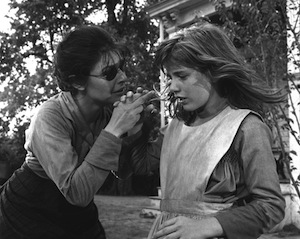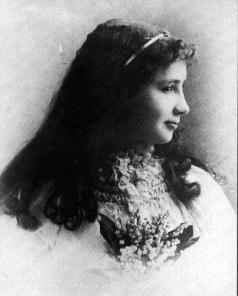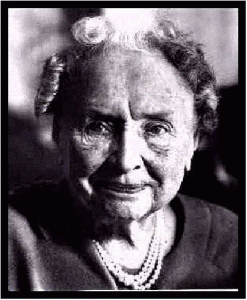THE MIRACLE WORKER
SUBJECTS — Biography/Keller; U.S. 1865 – 1913; and Alabama;
SOCIAL-EMOTIONAL LEARNING — Disabilities; Female Role Model;
MORAL-ETHICAL EMPHASIS — Responsibility; Caring.
AGE: 10+; No MPAA Rating;
Drama; 1962, 107 minutes; B & W.
There is NO AI content on this website. All content on TeachWithMovies.org has been written by human beings.
SUBJECTS — Biography/Keller; U.S. 1865 – 1913; and Alabama;
SOCIAL-EMOTIONAL LEARNING — Disabilities; Female Role Model;
MORAL-ETHICAL EMPHASIS — Responsibility; Caring.
AGE: 10+; No MPAA Rating;
Drama; 1962, 107 minutes; B & W.

At the age of six months, Helen Keller (1880 – 1968) suffered from a fever that left her blind, deaf and dumb. This film shows how, despite her disabilities, Helen Keller learned the meaning of symbolic language. With Anne Sullivan as her teacher, Helen Keller learned to read, write and speak. She graduated from Radcliffe College with honors in 1904 and became world famous for her triumph over her handicaps.
“The Miracle Worker” shows Anne Sullivan teaching Helen Keller the principal of symbolic communication, i.e., that shapes of the hand, when communicating in sign language, represent objects in the real world and concepts. The film is based on the Broadway play of the same name by William Gibson.
Selected Awards: 1962 Academy Awards: Best Actress (Bancroft), Best Supporting Actress (Duke); 1962 National Board of Review Awards: Ten Best Films of the Year, Best Actress (Bancroft); 1962 Academy Awards Nominations: Best Adapted Screenplay, Best Costume Design (B & W), Best Director (Penn).
Featured Actors: Anne Bancroft, Patty Duke, Victor Jory, Inga Swenson, Andrew Pine, Kathleen Comegys.
Director: Arthur Penn.
“The Miracle Worker” will help introduce children to Helen Keller and Anne Sullivan. Their story shows the strength and power of the human will and its ability to triumph over the most devastating disabilities. Helen Keller is one of the most remarkable people ever to have lived. She is a role model for a person who triumphs over profound disabilities. Anne Sullivan is a role model for a sensitive and innovative teacher. Without Sullivan, Keller would probably not have realized her great potential.
The film can also serve as a springboard for a discussion of the meaning and importance of symbolic language.
MINOR. This movie shows the South in the period called the “Redemption” when Southern whites regained control of the state governments after the collapse of Reconstruction. The men spend their free time reliving the lost war. The black characters in the movie are all stereotyped but they do not have important roles.
The teaching sessions sometimes degenerate into fights between Anne Sullivan and an undisciplined Helen Keller. These scenes may scare children younger than eight years.
Describe some of Helen Keller’s accomplishments and show your child her pictures reproduced in this Learning Guide. Read the poem she wrote which is copied in the Helpful Background section. Ask and help your child to answer the Quick Discussion Question.
Helen Keller wrote this poem:
They took away what should have been my eyes
(But I remembered Milton’s Paradise).
They took away what should have been my ears,
(Beethoven came and wiped away my tears).
They took away what should have been my tongue,
(But I had talked with God when I was young).
He would not let them take away my soul –
Possessing that, I still possess the whole.

Helen Keller’s books include The Story of My Life (1902). She became a leader for many reformist causes, including women’s suffrage. She was also a strong supporter of the Socialist Party, leading marches and demonstrations. She supported Eugene Debs (1855-1926), the Socialist candidate who ran for president five times in the early 1900s. Some believe that Helen Keller’s real legacy is as a social reformer. See The Truth about Helen Keller from Rethinking Schools Online.
The difference between communication among animals and communication among human beings is that we make use of symbols through language, while animals, for the most part, give only signals. Animals signal danger, happiness, pain, anger or their presence, but they do not express themselves with symbols. Only recently, with extraordinary efforts, have a few animals such as chimpanzees been taught to use a vocabulary of simple words.
In order for Anne Sullivan to begin to teach Helen Keller to read or write, Anne had to make Helen understand the concept of symbolism, that is, that one thing stands for another. In order to do that, she had to establish some discipline in Helen’s life. This movie is the tale of that process.

The Perkins School for the Blind is famous throughout the world for teaching the blind or sight impaired innovative ways to adapt to the world. It still exists today and is located in Newton, Massachusetts.
In the 1880s, when Anne Sullivan journeyed from Boston to the Keller’s home in Louisiana, the best method of long-distance travel over land was the railroad. The trip by horse and buggy would have taken months. The rail journey probably took more than a week.
At the dinner table, the captain and his son have a spirited debate over the abilities of Ulysses S. Grant, the Union General who finally beat Robert E. Lee in the Civil War. For decades after the Civil War and into the 20th century, many whites in the South refused to accept the defeat of the Confederate armies.
1. See Discussion Questions for Use With any Film that is a Work of Fiction.
2. Was Anne Sullivan right to use harsh methods with Helen? Why was discipline important to the process of teaching Helen the meaning of symbolic language?
3. What type of parents did Helen Keller have? In what ways were they able to help Helen and in what ways were they unable to help her?
4. Do animals communicate? How? What is the difference between communication among people and communication among animals?
1. Do you know any people who have overcome a handicap? Describe what happened.
2. Do you know any people who have not been able to overcome a handicap? Describe what happened.
3. There are two female role models in this film. Name them and explain why they are role models.
Discussion Questions Relating to Ethical Issues will facilitate the use of this film to teach ethical principles and critical viewing. Additional questions are set out below.
(Do what you are supposed to do; Persevere: keep on trying!; Always do your best; Use self-control; Be self-disciplined; Think before you act — consider the consequences; Be accountable for your choices)
1. How does Helen Keller’s life show that she honored this Pillar of Character?
(Be kind; Be compassionate and show you care; Express gratitude; Forgive others; Help people in need)
2. What was the basis of Ann Sullivan’s great achievement shown in this film? In most fields, is great achievement possible without caring?
See Assignments, Projects, and Activities for Use With Any Film that is a Work of Fiction.

Helen Keller’s autobiography The Story of My Life has been recommended for children ages 10 to 15. An excerpt concerning Helen’s discovery of the concept of words and naming as well as portions of Anne Sullivan’s letters describing the revelation can be found at pages 312 – 317 of The Book of Virtues (1993) by W. Bennett; Simon & Schuster. We suggest reading this section to children right after they see the film.
Dear Mr. Bell…Your Friend, Helen Keller by Judith St. George, Beach Tree Press, 1993, is also an excellent supplement for the film. Alexander Graham Bell, inventor of the telephone, had a lifelong interest in helping people with hearing disabilities. He is the person who advised Helen Keller’s father to hire a private tutor who was trained in working with deaf children. When Helen could write, she thanked Mr. Bell. This short book, intended for children, tells of their lives and friendship which lasted until Mr. Bell’s death 35 years later.
Other books suitable for readers ten years of age or older that relate to overcoming disabilities include: Run, Patty, Run by Cheila Cragg, Harper & Row, 1980 (a girl overcomes epilepsy by running); Marathon Miranda by Elizabeth Winthrop, (a girl overcomes asthma by running); A Handful of Stars by Barbara Girion (a high school sophomore learns to live with epilepsy); Geri by Geri Jewell (a young girl with cerebral palsy tries to become an actress); They Accepted the Challenge by Charles Kuntzleman (experiences of eighteen people who overcame their disabilities); The Mike King Story by Mike King (about his trip in a wheelchair from Alaska to the East Coast); One of the Lucky Ones by Lucy Ching (a Chinese girl becomes one of the first in her country to learn braille); and Vedi (a book about a blind child in India).
TWM offers the following worksheets to keep students’ minds on the movie and direct them to the lessons that can be learned from the film.
Film Study Worksheet for a Work of Historical Fiction and
Worksheet for Cinematic and Theatrical Elements and Their Effects.
Teachers can modify the movie worksheets to fit the needs of each class. See also TWM’s Historical Fiction in Film Cross-Curricular Homework Project.
What was the importance of Helen understanding that there was a word that meant water? What did that understanding lead to?
Suggested Response:
Once Helen understood that a word stood for something else, that it was a symbol, the secret of language was open to her. Before that, like most animals, she was limited to signs of what she wanted or felt, e.g., “I want mother,” “I want food,” or “I am angry.” When she learned that words were symbols for objects, Helen could progress to abstract thinking.
* we respect your privacy. no spam here!